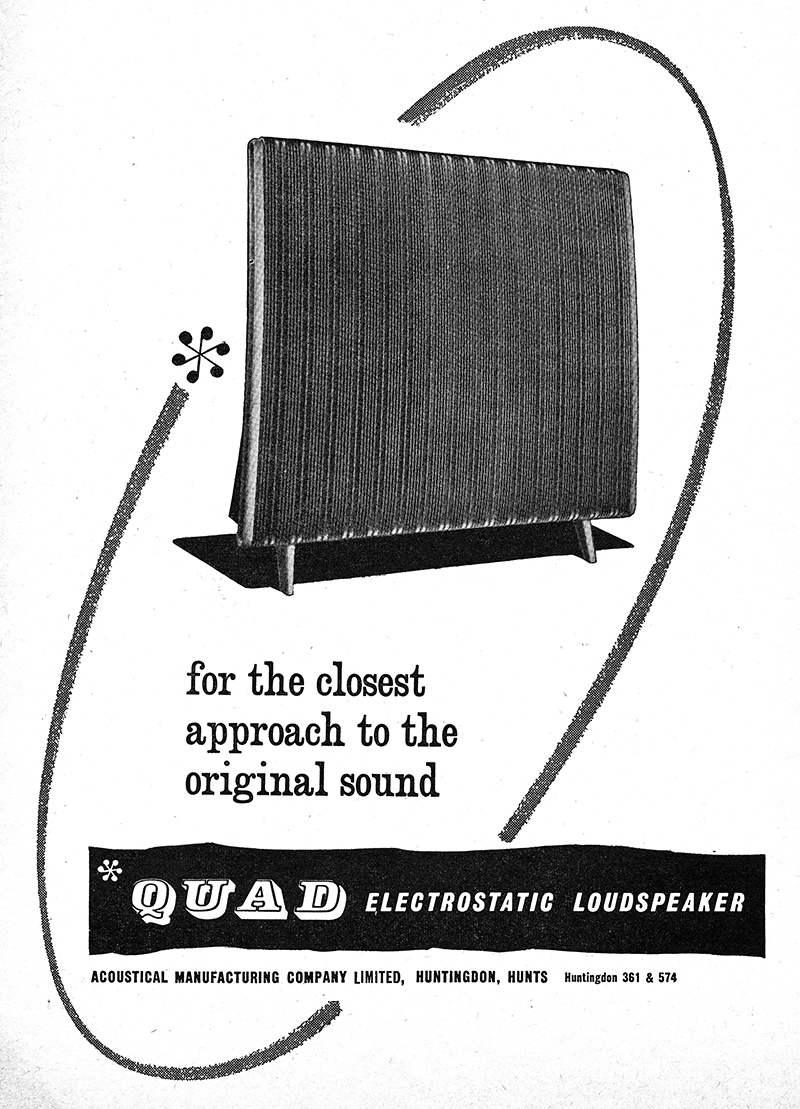|

This advert is for the first Quad electrostatic loudspeaker. Quad introduced this, the worlds first full range electrostatic speaker, in 1957 when it was priced at £52.00.
The ESL measures 31 by 34.5 by 10.5 inches (79 cm W 88 cm W 27 cm) and weighs 35 pounds (16 kg). In terms of appearance, the original ESL has an expanded metal grille, and three little wooden feet. The earlier version has golden-bronze grilles and classic teak end caps. Later production versions have black grilles, and end caps have a rosewood finish; other minor variants exist. The speaker's electronics components, consisting mainly of an audio transformer, EHT power supply, crossover and mains transformer, are fixed to the base of the cabinet.
An electrostatic speaker has only a frame to support the charged diaphragm. It uses ultra-thin stretched Mylar (Biaxially-oriented polyethylene terephthalate) film as the main component of its drive units. There are two perforated plates with a potential difference of up to 10,000 Volts, between which a very thin film, coated with a mildly electrically conductive substance, is sandwiched. Sound is produced when the audio signal amplified by a step-up transformer sets the film diaphragm into motion. The different charge between the two plates allows the diaphragm to be alternately attracted and repelled by each plate. In the original QUAD, two bass panels flank one treble panel to provide full range sound.
Its treble panel diaphragm is further subdivided into midrange and tweeter sections, achieved by clamping it on each side of its centre. Both midrange and tweeter sections are driven separately, and the entire treble unit operates at substantially lower voltages operating voltages are said to be 6,000V for the bass and 1,500V for the treble. The speaker needs to be plugged into the mains and must be charged prior to use. This is because the diaphragm operates in a "constant charge" mode, and it takes time for the charge to build up. In practice, the speaker is usable after charging for less than half a minute, but the sound gradually improves as the charge builds up. Best performance is achieved when the speaker has charged fully, which can take up to an hour. The electricity is only to charge the diaphragm, so consumption is negligible.
The electrostatic design does away with two major weaknesses of boxed speakers: enclosure colourations and signal degradation due to the crossover. The crossover in the ESL consists merely of resistors which work with the inherent capacitance of the speaker elements to obtain a first-order response. Because it is bipolar, both sides of the elements are not enclosed, but radiate directly into the air. Thus, colourations due to crossover components and box-induced reflections are minimised.
Fast transient response and low distortion are both characteristic of electrostatics. The driver, being only 0.00137-inch thick and weighing only 3 mg, is thus capable of stopping and starting seemingly instantaneously with no damping necessary to the drive units. However, the design also limits bandwidth to between 40 Hz and 10 kHz. Kohli of TNT noted that upper register starts to taper above 10 kHz and then falls off severely beyond 13 kHz, and is 15-20dB down at 20 kHz. The speaker's design makes them extremely directional, and the general practice is to toe in the speakers to point directly to the listener. Although a slight deviation did not seem to make a difference, it is in practice not possible for more than one person to enjoy a reasonably balanced sound stage with the ESL.
Contrary to the flat appearance of the loudspeaker, all three panels are slightly curved along the vertical axis to improve quality. The panels themselves are flat, but obtain their curvature by being slightly bent to a curved backing. With the bipolar nature of the speaker emitting sound from both front and back surfaces as it does, the application of a felt sheet to the rear of the panels damps and absorbs high frequencies radiating from the back. A crossover network, set at 500 Hz, remains necessary to adjust for back-to-front interference causing loss in output at low frequencies. In addition, the speaker should stand in free space to achieve optimum sound. The instructions book contains advice against placement of the speaker in corners or positions close to or parallel with walls, and further explains that a corner placement will adversely affect bass response and be detrimental to the midrange because of standing waves generated.
Its impedance is 1.8 Ohms at 20 kHz, to over 60 Ohms at 150 Hz, and its load is highly capacitive. It does not consume large amounts of power so much as it feeds it back to the amplifier in opposition at some points during each cycle. This is very demanding on amplifiers' stability.
Although it is designed to be used with the QUAD II, 303, or 405 power amplifiers with limiters, a power amplifier capable of delivering 15 watts per channel suffices excessive voltage input is known to cause arcing within the speaker panels. In fact, the instructions book states that any properly-regulated amplifier delivering no more than 33V is unlikely to cause damage to the speaker. Electrostatic speakers are more accurately rated by voltage, not power. In the ESL's case, at the rated nominal impedance of 16 ohms, the limit of 33 Volts would be reached when the amplifier's power output reaches 15 Watts (if it were driving a conventional load).
The most common failure modes were loss of sensitivity caused by dust infiltrating the speaker panels, and internal arcing of the panels caused by excessive power to the step-up transformer; use at high altitudes may also cause the same effect. Also, because of its novel electrical characteristics, the speaker could cause some amplifiers to become unstable and could result in damage to either or both. Late in the speaker's life, many owners found that the highly-stable 15 Watt Naim NAIT launched in 1983 worked well with the ESL.
Details courtesy of Wikipedia.
|